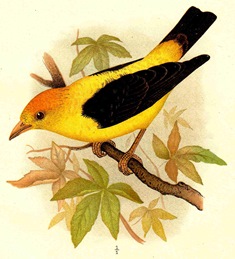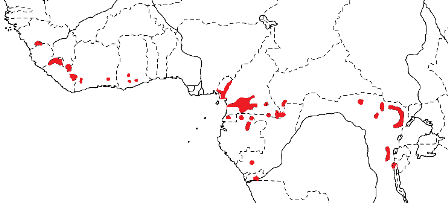Weaver Wednesday [93]: Preuss's Weaver 2014-03-26 (498)
 Weaver Wednesday
Weaver Wednesday


The Preuss's Weaver Ploceus preussi is a small 'nuthatch weaver'. The male has a black mask with an orange crown and forehead. The male differs from the very similar Brown-capped Weaver by its chestnut forehead merging gradually into yellow on the nape and it has a chestnut patch (instead of yellow) on the lower throat. The Preuss's Weaver male differs from the Yellow-capped Weaver in having a yellow (not black) rump. The female Preuss's Weaver has a black mask and band across the forehead, with the rest of the crown yellow, which distinguishes it from the Brown-capped Weaver and Yellow-capped Weaver females which both have black crowns. The juvenile Preuss's Weaver has a yellow-olive head and pale bill.
The Preuss's Weaver was named after Paul Preuss (1861-1926), a German botanist and collector in West Africa, who collected this species in May 1892.
The Preuss's Weaver occurs in West and central Africa, from Guinea to DRCongo (see map below, based on Birds of Africa). No races are currently recognised. Its distribution is very patchy, since its forest habitat is fragmented and reduced throughout its range.
The Preuss's Weaver inhabits the canopy of primary and secondary forests. It occurs alongside the Red-headed Malimbe in Liberia, foraging in a similar manner, and with the Yellow-capped Weaver in Cameroon. Adults are usually found in pairs, or in groups of l-4 birds which may be family parties, and in mixed-species flocks.

The Preuss's Weaver feeds mainly on insects, including eggs and larvae, grasshoppers and caterpillars. It also feeds on spiders and other bark-living arthropods. Hard seeds, perhaps from a berry, and a large earthworm have also recorded in its diet. The Preuss's Weaver runs along branches covered in epiphytes, gleaning on alternate sides, and hangs upside down on occasion. It also forages on boles of forest trees, and on dead trees.
The Preuss's Weaver is monogamous and a solitary breeder. Only one nest has been described, as a ball made almost entirely of greyish green Usnea. The nest was bound together with strips of palm leaves. The nest entrance is below, without a tunnel. The nest was fastened securely to small branches, 11 m high in a small tree. The eggs have not been described. Both parents feed the nestlings.
There are no PHOWN records for the Preuss's Weaver (see PHOWN summary), and many are needed. Submit any weaver nest records to PHOWN (PHOtos of Weaver Nests) via the Virtual Museum upload site.
PHOWN summary
Previous Wedn: Red-headed Malimbe
Full weaver species list
| 

 Weaver Watch
Weaver Watch


